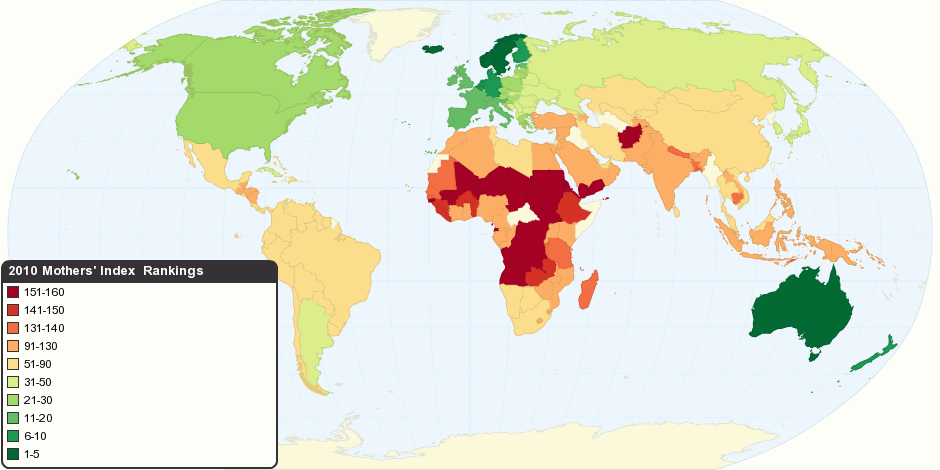This map shows 2010 Mothers' Index around the world. The Mothers' Index helps document conditions for mothers and children in 160 countries (43 developed nations and 117 in the developing world) and shows where mothers fare best and where they face the greatest hardships. All countries for which sufficient data are available are included in the Index.
Norway, Australia, Iceland and Sweden top the rankings this year. The top 10 countries, in general, attain very high scores for mothers’ and children’s health, educational and economic status. Afghanistan ranks last among the 160 countries surveyed. The 10 bottom-ranked countries (seven from sub-Saharan Africa) are a reverse image of the top 10, performing poorly on all indicators. The United States places 28th this year.
Conditions for mothers and their children in the bottom 10 countries are grim.
- On average, 1 in 23 mothers will die from pregnancy-related causes.
- 1 child in 6 dies before his or her fifth birthday.
- 1 child in 3 suffers from malnutrition.
- Roughly 1 child in 5 is not enrolled in primary school.
- Only 4 girls are enrolled in primary school for every 5 boys.
- On average, females have little over 5 years of formal education.
- Women earn only 40 percent of what men do for equal work.
- Nine out of 10 women are likely to suffer the loss of a child in their lifetime.
- Nearly 50 percent of the population lack access to safe water.
- Sixty percent of all births are not attended by skilled health personnel.
What is the Mothers’ Index Rankings?
The "Mothers' Index" is highlighted in Save the Children's State of the World's Mothers 2010 report, which compiles statistics on the well-being of mothers and children in 160 countries and uses them to produce rankings of nations corresponding to varying levels of economic development.
Key Indicators used:
The status of mothers was compared in 160 countries based on the following indicators of women's and children's well-being:
- Lifetime risk of maternal mortality
- Percentage of women using modern contraception
- Skilled attendant at delivery
- Female life expectancy
- Expected number of years of formal schooling for females
- Ratio of estimated female-to-male earned income
- Maternity leave benefits
- Participation of women in national government
- Under-5 mortality rate
- Percentage of children under age 5 moderately or severely underweight
- School enrollment ratios
- Ratio of girls to boys enrolled in primary school
- Percentage of population with access to safe water
These statistics go far beyond mere numbers. The human despair and lost opportunities represented in these numbers demand mothers everywhere be given the basic tools they need to break the cycle of poverty and improve the quality of life for themselves, their children, and for generations to come.
For more information please follow the reference link below.
15 years ago

